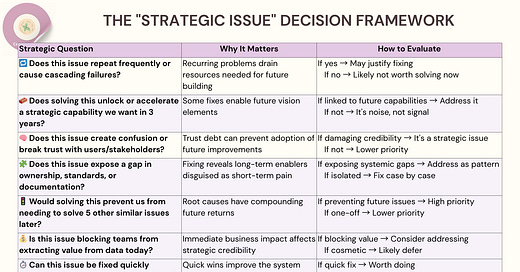The Art of Strategic Vision - Balancing Ambition and Reality | Wabi-Sabi Your Data
Master the 40/25/25/10 framework to evaluate data capabilities, calculate ROI, and create balanced implementation plans that deliver real business value.
(Paid user summary audio generated by notebooklm is behind the paid wall, it’s only 6.5 minutes)
Hello data Shokunin-deshi!
In our previous installment, "The Future Vision Framework - Building Your Aspiration," we embarked on the journey of defining our desired future state for data within our organizations. We explored the power of domain-specific workshops and the initial steps in identifying key capabilities.
Now, we arrive at a critical juncture: ensuring that our ambitious visions are grounded in reality. Just as a gardener must understand the limitations of their soil and climate to cultivate a successful harvest, data leaders must strategically evaluate and prioritize their desired capabilities to ensure they are both impactful and achievable.
Last year, my chili growing started really well. I was ready by February with my chili seeds—I sowed them, waited, and was rewarded with over 56 plants of different varieties. When the weather warmed, I moved the plants into my greenhouse and repotted them so they could continue growing. But I wasn't prepared for the snail attacks that followed, nor the frost. In the first week alone, I lost over 23 plants. I adjusted my approach and managed to keep the snails away, but ultimately only 6 plants survived to the hot summer months—and I'm ashamed to admit, two of those I bought from a shop.
What I learned from this experience was priceless: aspiration without preparation leads to disappointment. When we build our data vision, we need to identify early which initiatives will have the most impact on the business. There's no reason to pursue capabilities we're not convinced will set us up for future success.
Executive Summary
In this edition, I share how to balance ambition with achievability in your data strategy:
✅ Master the Capability Evaluation Framework to objectively prioritize your data initiatives
✅ Apply the 40/25/25/10 scoring system to focus on business value rather than technical elegance
✅ Learn techniques for estimating the monetary impact of data capabilities
✅ Discover how to balance strategic vision with practical implementation constraints
Reframing Present Noise: From Feedback to Focus
When working with Sarah at 4seconds.com (my client's pseudonym), we reviewed the feedback collected in the Present layer and realized that no less than 62% of the identified capabilities, issues, and blockers created a smoke screen obscuring what really mattered.
Not every signal from the Present layer deserves action. Many capabilities surface due to recent incidents, legacy frustrations, or low-impact requests. If we try to act on all of them, we dilute our focus. For example, complaints about dashboard color schemes, requests for duplicated metrics in different reports, or suggestions to rebuild a rarely-used legacy system based on a single user's preference all represent noise that can divert attention from more impactful initiatives.
That's why part of the evaluation process includes what I call the "Kintsugi Clarity Filter"—learning to say "not now" with confidence and documenting why, so stakeholders feel heard, not dismissed. Like the Japanese art of Kintsugi that highlights repairs in gold, this filter doesn't hide imperfections but helps us distinguish which ones deserve our immediate attention.
We needed a method to cut through the noise—what I call the "structured aspiration method."
The Wabi-Sabi approach differs fundamentally from traditional frameworks by starting with financial impact assessment rather than technology selection or architecture design. This perspective shift ensures we focus on business outcomes from the beginning rather than as an afterthought.
The Capability Evaluation Framework: From Vision to Reality
Central to successful Future Vision implementation is a structured approach to evaluating and prioritizing capabilities. Too often, data teams present solutions based on technical promise rather than business value. To truly earn a seat at the table with product, marketing, and finance, we must speak the language of impact.
The 40/25/25/10 Framework: Speaking the Language of Impact
This framework—a structured scoring system to prioritize data capabilities, projects, or initiatives—focuses on tangible impact on the organization.
Here's how it works:
Monetary Value (40%)
Revenue growth potential
Cost savings opportunities
Risk mitigation (e.g., compliance, fraud prevention)
Productivity improvements
Max: 40 points — because money still talks.
User Relevance (25%)
Number of users or departments impacted
Frequency of use
Criticality to business operations
Max: 25 points — because reach and relevance matter.
Vision Alignment (25%)
Links to strategic goals
Enables other capabilities
Supports a data-driven culture shift
Max: 25 points — because we're building more than just tools.
Risk Assessment (−10%)
Implementation complexity
Need for organizational change
Technical uncertainty
Max deduction: −10 points — because not all ideas are equally easy to pull off.
Implementation Tip: I provided Sarah with a simple scoring spreadsheet that workshop participants could use to rate each capability. This created transparency in the prioritization process and allowed for objective comparisons across domains.
Why This Framework Matters
Behind this framework is a fundamental shift in mindset: from discussing aspirations and tooling to discussing measurable business value. When we quantify impact in this way, we make it easier for cross-functional teams to align—and for data teams to influence the roadmap.
Pro Tip: Make it Collaborative
In Sarah's workshop, I used a simple spreadsheet where stakeholders scored each capability. This increased transparency and created a shared understanding across teams. You can even run this in a whiteboard tool like Miro or FigJam to make it more interactive.
🔒 For Premium Readers: Turning Vision into Strategic Reality
The following content is exclusively for premium subscribers who are serious about implementing a balanced data strategy that delivers real business value.
Keep reading with a 7-day free trial
Subscribe to Cooking Data guided by Lior to keep reading this post and get 7 days of free access to the full post archives.




